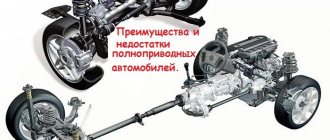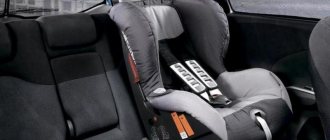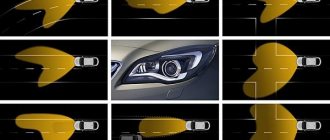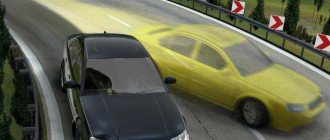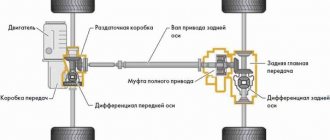Adaptive lighting system
The adaptive lighting system goes beyond the traditional low and high beam headlights, because...
Offers its own lighting mode for specific driving conditions. Adaptive lighting systems are constantly being improved: new functions are added and the capabilities of existing lighting modes are expanded. The first adaptive lighting systems provided additional illumination when cornering, such as Volkswagen's active headlight system. Wide possibilities for regulating the light beam have opened up using a video camera. The high beam control system allows you to drive with your high beams on at all times, without dazzling other drivers.
The leading developers of adaptive lighting systems are Hella, All Automotive Lighting, and Valeo.
The adaptive lighting system, being an electronic system, includes input devices, a control unit and actuators. Input devices provide information on the basis of which the system recognizes different driving modes:
Signals from input devices are transmitted to an electronic control unit, where they are processed using special software. As a result, the corresponding actuators are activated - xenon headlight modules. The module can be rotated in a horizontal and vertical plane. A screen is installed between the light source and the lens, the shape and dimensions of which make it possible to obtain a light beam with a given cut-off line. The xenon headlight can be equipped with an additional halogen lamp for better illumination of corners and roadsides.
Adaptive lighting systems from different manufacturers have one common name Adaptive Front lighting System , AFS . The exception is the BeamAtic from Valeo. Despite the common name, the functions of the systems may vary. In a modern adaptive lighting system, up to six lighting modes (functions) can be implemented:
- city light;
- country road light;
- highway light;
- high beam;
- dynamic cornering lighting;
- light in adverse weather conditions.
The city light mode is implemented at speeds up to 55 km/h. It is characterized by a short range, a horizontal cut-off line and a wide spread of the light beam. In city light mode, additional lamps in the headlights are activated. Allowing you to detect pedestrians on the side of the road when driving and turning.
Country road light is used outside the city at speeds from 55 to 100 km/h. At its core, this is a regular low-beam headlight, which is asymmetrical in nature (the right side is illuminated better than the left).
When the vehicle speed exceeds 100 km/h, the highway light mode . This lighting mode is a low-beam headlight with an extended range, which allows you to safely drive straight and in turns at high speed.
The high beam headlight mode works like normal high beam, but does not require the driver to switch to low beam. In controlling high beams, two approaches (methods) are implemented: adaptive or vertical cut-off.
Both methods of controlling high beams require the presence of a video camera. When vehicles are detected, the camera sends a signal to the electronic control unit. The system adjusts the headlights so that the light beam ends before the vehicle. The system also takes into account the terrain of the road (ascents, descents). If there is no traffic ahead, normal high beam headlights are used.
A more advanced solution is high beam headlights with a vertical cut-off line. This system combines the highest possible light beam, the best visibility and non-dazzle of other road users. If the system detects an oncoming or passing vehicle. It automatically shades the detected vehicle and accompanies it as it moves. Technically, this is achieved using a rotating cylinder located between the light source and the lens. The cylinder has an electromechanical drive. Light screens of various shapes are located around the circumference of the cylinder, allowing the implementation of a complex cut-off line.
The most common adaptive lighting mode is dynamic cornering lighting . Depending on the angle of rotation of the steering wheel and the speed of the vehicle, the headlight module rotates in the horizontal plane at an angle of up to 15°.
To improve visibility in adverse weather conditions (rain, fog, snow), an appropriate lighting mode has been created that provides a wider dispersion of headlight light. At the same time, to minimize glare from moisture particles in the air, the lighting range has been reduced.
AFLS
The work of the Adaptive Front lighting System, and this is the name of the adaptive lighting system, consists of a comprehensive analysis of the road situation and automatic adjustment of the light beam to the vehicle's driving conditions.
Components involved:
- servo drives for rotary lamp modules;
- ECU;
- sensor equipment. Wheel speed sensors are used to calculate the speed of the car, a steering angle sensor is used for the system to understand the direction of movement, and a longitudinal direction sensor is used to analyze the road profile. As auxiliary devices, a rain and light sensor is used, which allows you to evaluate the intensity of light and the presence of precipitation (the headlights occupy a position that minimizes the glare effect of wet asphalt);
- camcorder. Constant analysis of the image from the video camera allows you to record the presence of pedestrians, oncoming and passing traffic.
The abbreviation AFLS serves as an international designation and is used by all automakers; only occasionally you can find the name BeamAtic, used by Valeo. The adaptive lighting system is an option, but even if available, it will only be activated when the headlights are in automatic mode. The function can be automatically deactivated if the vehicle's Stability Program (ESP) is activated. This is necessary to prevent chaotic changes in lighting modes and changes in the direction of light rays when the driver tries to get out of a skid using intensive emergency steering. The principle of operation of AFLS on different cars is very similar, so the main difference is the number of road lighting modes, as well as the speed at which the type of lighting will be changed.
Adaptive light
Adaptive light is a headlight system that automatically changes the direction of the light output of the headlights synchronously with the direction of movement of the car. The system was developed by designers at Volkswagen AG and was called the Advanced Frontlighting System, or AFS for short. Some models of Volkswagen Phaeton, Volkswagen Touareg, Volkswagen Passat and others are optionally equipped with adaptive light. Adaptive lighting systems are also produced by other companies, in particular -. Its AFL system differs from AFS in that it includes an additional pair of auxiliary headlights that turn on when the steering wheel is turned sharply and illuminate the right and left sides of the road as the vehicle moves.
AFS system
The prototype of the modern adaptive lighting system was the “AFS” system (Advanced Frontlighting System). This system ensures that the headlights remain stationary, while the beam of light is adjusted by turning the light block, which drives a precise stepper motor. This system is universal and easily adapts to European, Japanese and Korean cars. The statistics are inexorable - cars equipped with an adaptive lighting system are three times less likely to get into accidents compared to similar cars without this system. Such statistics are the main argument in favor of adaptive headlights, thanks to which most leading manufacturers are trying to integrate this system into the basic configuration of their cars.
Rationale for using adaptive light system
When driving a vehicle equipped with a conventional headlight system at night or in poor visibility conditions, the driver is unable to obtain complete visual information. The side of the road, objects on it remain out of clear visibility. An animal or a large object (a branch, a tree trunk) suddenly running onto the road can lead to an emergency. However, rigidly mounted headlights, even if they are correctly adjusted, illuminate a limited space in front of the car and, to a much lesser extent, the space to the sides of the direction of travel of the car. An adaptive lighting system can be compared to a flashlight used by a pedestrian. If a flashlight is rigidly attached to a pedestrian’s clothing or headdress, only the space in front of the walking person will be illuminated. This is an analogue of a traditional headlight system. If you take a flashlight in your hand, it will illuminate the path along which a pedestrian is moving, including turns, bends in the path, potentially dangerous objects that are difficult to see in the dark. This is analogous to a car's adaptive lighting system. On motorcycles and scooters with headlights mounted in the head fairing (sportbikes) or in the front shield (scooters), the lighting system works in the same way as on cars with straight-line beams. On motorcycles and scooters with headlights mounted on the steering column (most general purpose motorcycles, choppers, enduro and others) or on the handlebars (Vespa scooters and others), the lighting system works as a conditionally adaptive one, since the light beam from the headlight turns simultaneously with the turn steering wheel Experts from European insurance agencies note that cars equipped with an adaptive lighting system get into accidents 40% less often than cars with straight, traditional light.
AFS Russia
Home → Education → Academic programs → AFS Russia
Interculture Foundation – AFS Russia
Website of the Interculture Foundation www.afs.ru
History of international exchanges
The idea for the programs originated in 1914 among American Field Service (AFS) volunteers transporting wounded from the battlefields of World War I, who decided that people should learn to overcome the mutual animosity and animosity caused by wars by exchanging young people who would live in families ordinary people, attend local schools, learn the language and culture. The experience was successful and spread throughout the world and was supported by the governments of many countries. Since 1947, the AFS International Organization has carried out regular youth exchanges between 56 partner countries. The work of all national offices is coordinated by the international headquarters in New York.
Official status of AFS programs
All programs are carried out under the auspices of the UN and the Council of Europe. In Russia, AFS programs are implemented with the support of the Ministry of General and Professional Education of the Russian Federation. Stagecoach Travel is the official regional representative of AFS.
Uniqueness of the program
Exchange of high school students aged 14-18 who study in local schools and live with host families. Having lived for a year in a country with a different culture, language and way of life, a young person gets the opportunity to fully realize all previously hidden abilities, including the ability to adapt to any conditions and communicate with people of different cultures, views and beliefs, set goals and achieve them . This is a fantastic leap in development.
World Leaders Club
Graduates of AFS programs are called the “Golden Fund of the Nation.” During the year spent abroad, students decide on their future path in life and the direction of their professional activity. According to AFS statistics, graduates subsequently become successful businessmen, politicians and even presidents of countries. The undoubted advantage of program graduates is that they have excellent knowledge not only of the language, but also of the mentality of another country.
Preparation before departure
We will provide you with the support you need before, during and after the program. We will take care of all issues related to the trip, select a suitable host family and school, provide assistance in preparing documents, obtaining a visa, air tickets, and conduct an orientation course that will help you adapt to new conditions.
Homestay
Program participants receive a unique opportunity to live as a family member in another country. Along with everyone else in the host family, you participate in family holidays, trips and household chores. Families are carefully selected according to the interests and lifestyle that resonates most with you.
Well-organized leisure time
Family and school life are full of exciting activities and entertainment. You can join a sports section, a theater club, or spend evenings with friends in clubs or at a disco.
Opportunity to continue studying abroad
It is possible that after a year spent at school abroad, you will want to enroll in a higher education institution abroad, take an internship in one of the foreign companies or obtain additional qualifications in business. Remember that Stagecoach Travel will always give you qualified advice, help you collect the necessary documents, organize your trip and get comfortable.
Who can become a participant in the program
- Any student of a Russian secondary school, gymnasium or lyceum between the ages of 15 and 18, who is able to adapt to a new way of life.
- A basic knowledge of English or the language of the country you would like to travel to is desirable (but not required).
How to apply
- fill out the application
- You and your parents will then be invited to an interview.
- You will fill out a specially designed questionnaire that will allow you to assess your readiness to take part in this kind of international program.
- After the contract is signed and the first part of the fee has been paid, you will fill out a detailed questionnaire, which is sent to the host country.
- Then, we wait for a response from the host country - whether your participation in the program is guaranteed or not. If yes, congratulations! You, your parents or sponsors only have to pay the rest of the contribution. Stagecoach-Travel employees will inform you additionally about the deadlines for submitting the documents required to obtain a visa.
Application deadlines
- Applications can be submitted 9 months before the start of the program
- We process applications in the order they are received. The earlier you apply, the better your chances of getting a place.
- Applications must be submitted no later than March 10 for countries in the Northern Hemisphere and no later than August 10 for countries in the Southern Hemisphere.
All questions can be asked to the manager in our office by phone in Saratov, 27-97-94
Design and operation of the adaptive light system
The car's adaptive lighting system is controlled by an on-board computer that reads information from sensors of the steering angle, vehicle speed, vehicle position relative to the vertical axis, the vehicle stability control system (ESP) and even the operation of the windshield wipers (to determine changes in road conditions when it begins to rain or snow). Adaptive headlights use only bi-xenon light sources. The headlights themselves are equipped with stepper motors with small increments that move the headlight housing in all directions by a maximum of 15 degrees. In this case, the amount of rotation of each of the two headlight units differs. When turning left, the left headlamp turns a full angle, the right one - half of this angle (for example, 15 and 7 degrees, respectively). When turning right, the left headlight turns at a smaller angle. This reduces the risk of blinding drivers who are driving on the road into which the car is turning. Adaptive lighting works in both low and high beam modes. With constant steering (yaw), the ESP sensor informs the on-board computer that there is no change in direction of movement - the headlights shine straight, the adaptive lighting system is turned off. As soon as the driver turns the steering wheel to the right or left at a large angle, the adaptive light system is activated - the headlights are turned by stepper motors, and the light beam changes direction. In this case, the internal headlight relative to the center of the circle described by the car turns to a larger angle and illuminates the space adjacent to the central part of the arc, the external headlight illuminates the outer part of the arc and partially the central part of the road. The area of the illuminated space increases - the driver receives complete visual information about the road situation. When a powerful oncoming light source appears directly ahead, the computer commands the stepper motors to turn the headlights downwards along the vertical axis. As a result, the beam of light lowers slightly, preventing the effect of blinding the driver of an oncoming car. As soon as the cars pass each other, the headlights return to their original position. The same command to change the direction of the light flux is received when the windshield wipers are operating. The light beam drops lower than in the case described above - the headlights begin to work like fog lights. In this case, the luminous flux extends to a height of no more than half a meter, “under the fog,” so that the light does not reflect from the microdroplets of the water-air suspension that makes up the fog. During rain and snowfall, the effect of the “fog” light is significantly lower, but still changing the vertical direction of the light flux significantly reduces the risk of blinding the driver by the light reflected from raindrops. The adaptive system changes the direction of the light flux both horizontally and vertically. For example, on a long descent, the light beam rises, illuminating the opposite slope, and on a steep climb, it lowers so as not to blind drivers of oncoming cars ascending the mountain from the opposite side. The computerized adaptive light system operates very smoothly. The only noticeable effect of the use of adaptive light is a clear improvement in road illumination in all driving modes and in any road situation. The improved AFS system and some competing systems, in particular AFL, differ from the one described in that they are equipped with additional side-lighting headlights. These small headlights, equipped with fairly powerful light sources, turn on separately when the steering wheel is turned sharply, illuminating the right side of the road when turning right, and the left side when turning left. As soon as the steering wheel assumes a neutral position and the vehicle's trajectory straightens, the headlight involved in the side lighting - left or right - turns off.
Prospects for the development of an adaptive light system
Volkswagen AG specialists are developing a next-generation adaptive lighting system. Its peculiarity is that any lighting mode will become adaptive. There are four such modes in total. The first is highway lighting, the most powerful, which uses all the light sources of the headlights. The second mode is lighting for suburban highways, which turns on the light corresponding to the current low beam. The third is lighting for traffic in urban environments, low beam of lower intensity, but with an expanded light spot. And finally, the fourth mode - lighting in bad weather conditions, corresponds to the illumination of the road with fog lights. The new adaptive light system provides more degrees of freedom for turning the headlights, more precise control and additional combinations of lighting devices depending on the road situation.
Can I install the headlights myself?
Today, cars equipped with an adaptive lighting system have a high price, which is why there are so few of them on domestic roads. However, some cars can be equipped with an analogue of “smart” light for little money.
Despite the fact that it will not be possible to achieve full modern lighting, the headlights will be improved with a rotating mechanism. However, before purchasing the necessary parts and elements, it is important to make sure that the wiring is suitable for the car’s headlights, since without it, modernization is impossible.
If the wiring is found, you can begin the direct installation of the device. To do this, you need 2 sensors, which are installed on the front wheels of the car and connected to the headlights using wiring. To control the adaptive, the LCM module located to the left of the steering wheel is used. New parts also need to be connected to it.
Such an upgrade requires certain skills and abilities, and it is also important to determine the compatibility of old and new elements.
If you want to improve your lights, it is better to contact professionals who can select the right device for a specific car make.
The headlights that most cars are equipped with have long been outdated and cannot guarantee the safety of road users at night. For this reason, adaptive diode lighting is becoming more and more popular every year, changing the direction of the light beam along with the rotation of the front wheels of the car. This lighting system improves the driver’s visibility and allows him to clearly see all obstacles on the road, regardless of the time of day.
What is an adaptive lighting system in a car?
The vehicle's adaptive lighting system is designed to increase safety while driving. Smart headlights installed on cars no longer require manual adjustment, since all changes occur automatically. The system is integrated with various vehicle modules and is controlled by an electronic unit that processes information about the external environment and changes the operating mode and brightness of the optics.
Dynamic adaptive light
Let's look at the most common examples when standard headlight modes are not enough:
- A driver drives along a highway at night with his high beams on. When a car is moving towards you, it is necessary to switch the lights to low mode so as not to create an emergency situation. Adaptive LED headlights will be able to independently change the illumination without human intervention.
- Sharp turns are always accompanied by risks at night. During a maneuver, the light cannot cover the entire section of the road, so the driver controls the car based on visibility and intuition. But the design of the adaptive system allows you to illuminate the entire route.
The system can adapt lighting intensity and cornering optics based on external conditions.
Can't open .afs file?
If you want to open an .afs file on your computer, you just need to have the appropriate programs installed. If afs association isn't set correctly, you may receive the following error message:
Failed to open this file:
file: example.afs
To open this file, Windows needs to know what program you want to use to open it. Windows can go online to search for it automatically, or you can manually select from a list of programs installed on your computer.
Purpose and operating modes
Adaptive headlights can increase traffic safety in bad weather conditions and improve visibility of the route. This is realized thanks to the design features of the system and the presence of an electronic control unit. Adaptive optics, depending on the type of vehicle and installed sensors, can provide up to six light operating modes:
- urban - short range of wide illumination at speeds up to 55 km/h;
- country lane - near asymmetrical light flux when driving from 55 to 100 km/h;
- highway - long-range low beam lighting that does not blind oncoming drivers;
- high and low beam - standard light with automatic switching without human intervention;
- cornering lighting - changing the plane of inclination of optical lenses depending on the angle of rotation of the steering wheel;
- for unfavorable conditions - brightness control based on readings from external sensors.
Types of adaptive systems
A large number of accidents on roads at night occur due to poor lighting. Drivers cannot see obstacles on the road, the exact turning radius, or moving pedestrians or cyclists. All this leads to dangerous situations and increases the likelihood of an accident. To cope with the problem, manufacturers have developed smart headlights. Depending on the design features and operating principle, two main types of solutions are distinguished:
- adaptive road lighting system Adaptive Front light System (AFS);
- adaptive head lighting system Adaptive Forward Lighting (AFL).
Urban lighting mode at speeds up to 50 km/h
Despite different names and design differences, both solutions have similar functionality.
The benefits of adaptive optics for drivers
Adaptive headlights illuminate the section of road required in each specific traffic situation, which helps reduce the risk of accidents at night. It is the increased safety for drivers that is the main advantage of adaptive optics, which conventional car headlights do not have.
According to statistics, owners of vehicles equipped with “smart” optics get into accidents 40% less often than their colleagues with standard lights. The capabilities of adaptive lights allow the driver to drive his car comfortably and without unnecessary strain on the eyes, which is also a significant advantage of modern optics.
In addition, the smart light maintains the driver's visibility even in bad weather conditions.
Despite all the advantages of adaptive devices, only a small part of modern cars are equipped with them. This is due to the high cost of such equipment.
Design and principle of operation of the AFS system
Volkswagen's AFS is a solution for adaptive and dynamic headlights that changes the direction of the light flow. The car is equipped with xenon headlights with tilt control (LWR), a special AFS sensor and a control unit connected to other vehicle modules to receive data and change the lighting angle. Let's look at how standard adaptive headlights work:
- The control unit receives data from a video camera, ambient light sensors, acceleration, wheel speed, and steering wheel rotation.
- Depending on the received parameters, the system analyzes the type of lighting (city, highway, for turns) and the current road situation.
- The electronics provide a control signal to the LWR system.
- The brightness and rotation angle of the light beam are corrected using an installed electric motor.
Turning lighting with standard optics and using AFS
To turn on the AFS system, you must set the switch to Auto mode. Based on the speed of movement, the system will change the light parameters.
The AFS control unit actively detects corners, standard urban and highway driving, and also analyzes information from other vehicle modules to recognize bad weather conditions.
Design and principle of operation of the AFL system
The AFL development from Opel is a combined lighting control option that reacts to the steering angle and turns on additional light bulbs in the headlights. The main feature of the system is that AFL begins to monitor the steering angle and change the direction of the light only at high speeds. In all other cases of maneuvering, the electronic unit simply turns on an additional backlight.
The critical driving speed for changing the lighting angle is 70 km/h.
AFL adaptive headlights use special optics that provide the same light intensity in high and low range modes. The following must be added to the additional properties of the system:
- changing the angle of light beams from adaptive headlights by 15 degrees;
- improvement of road illumination at turns by 90%;
- increasing traffic safety at intersections thanks to side lights;
- protection against false alarms when changing lanes.
Adaptive headlights provide bright and intense light output and allow you to forget about manual lighting control. You no longer need to think about oncoming cars and switching the light mode. The main disadvantage of AFL is the high cost and difficulty of repairing headlights if damaged.
AFL system
An analogue of the adaptive lighting system described above is the AFL (Adaptive Front-Lighting System), its difference is the presence of an additional pair of headlights. The auxiliary headlights are activated only after a sharp turn of the steering wheel, and the beam of light is directed towards the appropriate side of the road. The auxiliary headlights are equipped with fairly powerful light bulbs, so even when switched on separately, they do an excellent job with their task and perfectly illuminate dangerous sections of the road. In essence, this arrangement combines static side light with the function of dynamic control of the main headlights. On difficult and uneven road sections and in narrow alleys, such a system provides many advantages. When driving on highways on sharp turns, the main headlights of the AFL rotate through a large angle, the magnitude of which depends on the speed of the vehicle. It is important to note that, like modern systems, AFL rotates the right and left light beam at different angles, thereby expanding the range of the light sector. The process is controlled by a controller that analyzes information coming from speed sensors and steering wheel sensors. When driving through intersections and narrow areas at low speeds, an additional side headlight is activated, which reacts to the turn signal and steering input. The backlight turns on instantly as soon as the driver begins a turn.
What does AFS OFF mean?
The inscription AFS OFF on the dashboard indicates that the adaptive headlights are disabled. If the system was not intentionally turned off, you must reactivate the function and the notification will disappear. If it doesn’t help, then the reasons why AFS OFF appears may be related to malfunctions:
- AFS control unit;
- steering wheel position sensor;
- AFS sensors;
- wiring, etc.
If such a malfunction occurs, you should first study the vehicle’s operating instructions in detail; if a solution is not found, contact a service center for diagnostics.
Flashing AFS OFF
Optics halogen. Without parking sensors.
Engine Kashirskaya, st. Ru Analysis of Audi A8 4.
In stock! All purchased spare parts are guaranteed for installation and testing for up to 30 days!! Warehouse address: Rear Axle.
Oil pump. Cylinder head.
Sensor for Toyota,Lexus Lexus IS 250/350 2005-2013
body position sensor lexus is 250 valve cover. Cylinder head cover. Crankshaft damper. Electric water pump. Intake Exhaust manifold. Vacuum pump. Ignition coil. Power steering.
Power steering pump. Air conditioning compressor. Automatic manual transmission. Transfer case. High pressure fuel pump. Executive node. Oil level sensor. Crankshaft sensor. Camshaft sensor. Air flow meter. Oil glass. Fuel rail. Engine mount. Throttle valve. Rounded fist. Steering rack. Brake disc. Steering cardan. Steering shaft section. Exhaust pipe. Cardan Shaft.
Rear body position sensor lexus is250 (AFS)
Stop signal. Anti-fog headlight. Front bumper. Rear bumper. Front door. Back door. Door lock. Trunk lid. Door handle.
Bumper grille. Strengthener of bumper. Front Panel. Xenon headlight adaptive LED. Radiator cassette. ABS sensor. ABS block.
What is the AFLS system?
A technical solution for adaptive headlights from Mazda, which controls the tilt of the optics vertically and horizontally. The AFLS system performs the following functions:
- dynamic lighting when turning - changes in illumination up to 15 degrees;
- tilt angle correction - the system’s response to the vehicle’s position and load level;
- automatic light control - high and low mode, side lighting to improve visibility.
The maximum vertical compensation is 7 degrees. Large tilts are not allowed to avoid blinding oncoming drivers.
In the near future, vehicle optical systems will change dramatically. This is evidenced by adaptive and matrix headlights, which significantly increase driving safety and illumination on the road. Drivers will be able to concentrate on driving without thinking about switching lights.
Adaptive road lighting system AFS
Adaptive road lighting system AFS in Toyota Land Cruiser Prado
The direction of light while the car is moving has always been the main characteristic that ensures normal visibility and, accordingly, safe driving at night.
And on relatively flat sections of the road, the traditional (fixed) position of the headlights is quite enough. But if the road surface often changes its direction, the direction of the light flux changes along with it. In this case, large unlit areas begin to appear.
Moreover, the car is already turning, but the light is still directed slightly in the other direction, not illuminating the inside of the turning arc. It turns out that the light beam does not keep pace with the car’s maneuver, since the direction of the light beam cannot change.
The AFS adaptive road lighting system solves the problem of correct direction of light.
How does the adaptive lighting system work?
The headlights used in the adaptive lighting system are not strictly tied to the body structure. They can move in both horizontal and vertical planes. The movement of the headlights is controlled using stepper motors. Stepper motors are designed in such a way as to change the position of the shaft depending on the intensity of the electrical impulses.
Smooth turning is achieved through the use of a worm gear reducer.
Stepper electric motors are connected to a control unit, which receives information from several sensors. The system receives information from the following sensors:
- Steering wheel sensor;
- Vehicle speed sensor;
- Vehicle position sensor relative to the vertical;
- From the car's exchange rate stability system;
- From the windshield wiper system.
As soon as the steering angle sensor transmits a change signal,
AFS
adaptive road lighting system reacts by turning on stepper motors that turn the headlights to a certain angle. Moreover, the left and right headlights do not turn at the same angle.
What are adaptive headlights and adaptive lighting?
The adaptive lighting system has gone beyond the classical lighting system , since it offers a completely new approach - adjustment to different conditions.
There is a large field for activity here - manufacturers are constantly adding to the technology and improving it. If you try to answer the question “what are adaptive headlights”, then this is a special element of lighting that automatically adapts to driving conditions - when cornering and when changing speed. When turning in a certain direction, the light beam follows the direction of the steering wheel. The system is represented by three main components.
- Special devices (process data that subsequently recognize the position in which the car is moving). Here, each indicator is responsible for individual parameters:
- angle – for the direction of movement;
- lighting – for brightness;
- video camera – for objects (passers-by, pillars, animals);
- wheel - for speed;
- longitudinal acceleration – beyond the profile of the road part.
- Monitoring and control unit.
- Mechanisms that bring change.
Initially, adaptive road lighting systems improved visibility on turns (the developer was the German automobile concern Volkswagen). Installing a video camera also made it possible to adjust the light beam. The high beam has been improved to the point where it does not blind oncoming traffic and you can keep it on all the time.
Among the famous companies that develop adaptive lighting are All Automotive Lightning, Hella, Valeo.
Adaptive headlights are directed in the direction of turns, improving road illumination, in addition, the vehicle's maneuvers are better visible to other road users.
AFL and AFS road headlight systems
The problem of good visibility when driving a car arose almost simultaneously with the car itself. At one time, to ensure this, both kerosene lamps and other, sometimes quite exotic, light sources were used. However, even the current lighting system is not final; it is constantly changing and improving. An example of this is an adaptive lighting system.
How and what should be illuminated?
The problem of traffic safety, especially in poor visibility, as well as in twilight and darkness, is directly related to the lighting of the road along which the car is moving. But there are several mutually exclusive points here:
- the road must be illuminated at a considerable distance in front of the vehicle so that the driver can take timely measures to prevent danger;
- the roadside must be illuminated, allowing timely detection of pedestrians and animals near the roadway;
- the intensity of the light should be such as not to blind oncoming drivers;
- The brightness of the light should be different in city and country road conditions.
The classic headlight system is divided into low and high beams, which shine only directly, but each of them has its own purpose. If the low beam is intended to illuminate the side of the road and the road at a short distance ahead, and is also used when passing oncoming cars and driving in the city, then the high beam is turned on when driving on country roads, illuminating the road far ahead.
Adaptive road lighting
Many people have worked and are working on the problem of creating safe conditions when driving in the dark class=”aligncenter” width=”500″ height=”306″[/img]
The point is that adaptive lighting is used, which can be implemented in the following ways:
- use an additional light bulb for illumination when maneuvering (at speeds up to seventy km/h). A similar lamp turns on when you turn the steering wheel or change the position of the turn signal;
- use turning headlights. With such head adaptive cornering lighting, the headlight turns, depending on the speed of movement, following the steering wheel by fifteen to twenty-two degrees when turning outward and up to seven degrees when turning inward;
- use both methods of adaptive lighting.
How these systems work
Currently, different manufacturers have implemented several different options for adaptive headlights, of which AFS and AFL can be mentioned.
How does AFS work?
A similar system was developed for cars of the Volkswagen family. It implements the principle of changing the position of the headlight. The AFS system is built on the fact that when the vehicle maneuvers, the computer changes the position of the headlights in accordance with the change in the position of the steering wheel. Each headlight rotates at its own angle; for internal rotation it is larger, for external rotation it is smaller.
To assess the magnitude of the required change in the position of the headlights, the AFS headlight system uses the measurement results of numerous sensors available on the car - steering wheel position, speed, directional stability, etc. For example, changing data from the ESP (stable stability) sensor indicates that the car is in a maneuvering state, which means that AFS will turn off and the headlights will not follow the curves of the road. The light will only be directed straight ahead.
AFS only works with bi-xenon devices, both high and low beam.
About the work of AFL
The AFL adaptive lighting system is used on Opel family cars. It is a combined option. To provide adaptive lighting, the AFL system, like the AFS, uses headlights to rotate when the steering wheel position changes, but in addition there are additional backlights.
When the car is moving at high speed, the AFL headlight system monitors steering wheel turns, according to which it turns the headlights. However, at speeds below seventy kilometers per hour, AFL turns on an additional light with a wide illumination angle when performing maneuvers. Thanks to this, turns are illuminated, and maneuvering in narrow places and at intersections becomes much safer.
An additional advantage of AFL is that it is speed dependent - when maneuvering or changing lanes on a motorway, the AFL system will not turn on. The use of bi-xenon headlights ensures equal illumination on low and high beam, because One light bulb is used for this. AFL switches from high beam to low beam automatically.
Ensuring safety when driving a vehicle is always one of the main tasks of manufacturers. This becomes especially relevant in dark times. One of the options for solving this problem was the creation of various options for adaptive head lighting, allowing the driver to significantly improve visibility at night. » alt=»»>
Error codes on Lexus brands: injector error, how to reset the error
Lexus is a car whose name speaks for itself. Luxury, convenience and envious glances of other drivers are guaranteed. However, unfortunately, there are no ideal cars that do not require maintenance and other care. It happens. that there is a problem with the car that requires an urgent and immediate solution. Before starting repairs, you need to identify the location and cause of the breakdown.
If an engine malfunction or emissions problem occurs, the amber "check engine" light on the instrument panel will illuminate. In some Lexus models, the error will be accompanied by “cruise control”, turning off TRAC or “VSC”. This description is only a small part of what options there may be.
This article describes in detail the types of breakdowns, Lexus diagnostic trouble codes and ways to repair the car.
Error U1117
If this code is displayed, it means there is a problem with data exchange with the auxiliary equipment gateway. This reason can be easily identified, since it will be impossible to receive data from the additional connector. DTC Output Confirmation Operation: Turn the ignition switch (IG) ON and wait for at least 10 seconds. There can be two faulty areas:
Error codes for Lexus
- Auxiliary bus connector and breakout bus 2 auxiliary connector (bus buffer ECU).
- Internal fault of the auxiliary connector (bus buffer ECU).
Fixing this breakdown on your own is quite problematic and difficult; moreover, if the breakdown repair sequence is carried out incorrectly, you can damage the car even more. It is better to contact an experienced master. After repair, you should be on the safe side and make sure that the DTC is not output.
Error B2799
Error B2799 - Engine immobilizer system malfunction. Possible malfunctions:
- Wiring.
- Immobilizer code ECU.
- When communicating between the immobilizer and the ECU, the communication ID does not match.
Procedure for troubleshooting:
- Reset the error using the scanner.
- If that doesn't help, check the wiring harness. Checking the contacts of the immobilizer code ECM and ECM and the nominal values can be easily found on the Internet or on the official website of the representative.
- If the wiring is normal, check the operation of the immobilizer code ECU.
- If the ECU is working properly, then the problem is in the ECM.
Troubleshooting Lexus
Error P0983
Shift solenoid valve D - high signal level. This error may appear and disappear at the initial stage, but you should not forget about it. The two highest gears may be disconnected and other unpleasant moments may arise. To fix the problem you will have to purchase:
- automatic transmission filter;
- rings for drain plugs;
- automatic transmission pan gasket;
- oil;
You can change the box yourself, but it is better to contact an experienced specialist.
Error C1201
Engine management system malfunction. If after resetting and re-checking the error appears again, then either the ECM or the skid control ECU must be replaced. More precisely, first change the ECM, and if that doesn’t help, then the anti-skid ECU. There is no point in checking the sensor or sensor circuit at all.
To eliminate the error, you can try to reset it, remove the terminals, or find the cause in other errors. If after a reset it appears again and other errors do not appear, it means that one of the above-mentioned blocks has been short-circuited. Another option is to try checking the block contacts and cleaning them.
However, all of the methods listed are proposed as options and it is not a fact that they will be suitable in a particular case. To be sure, please contact your dealer for assistance.
Error P2757
Torque Converter Clutch Pressure Control Solenoid Control Circuit Performance or Locked Off Many owners of a car of this brand are well aware of this problem. Its solution is not found as easily, and not as quickly as we might like. On the Internet, technicians advise checking the computer; if everything is not restored at an early stage, then replacing the automatic transmission will not be avoided in the future.
Read more in the Lexus News section.
Error PO171
The mixture is too lean (B1).
- Air intake system.
- Clogged injectors.
- Air flow sensor (flow meter).
- Coolant temperature sensor.
- Fuel pressure.
- Leaks in the exhaust system.
- Open or short circuit in the AFS sensor circuit (S1).
- AFS sensor (S1).
- AFS sensor heater (S1).
- Main relay for the injection system.
- AFS and EFI sensor heater relay circuits.
- Crankcase ventilation system hose connections.
- Hoses and valve of the crankcase ventilation system.
- Electronic engine control unit.
Possible solutions to the problem are cleaning the VVT valves, replacing the cam sensors, and replacing the OCV solenoid.
Lexus car repair
Error P2714
The performance of the solenoid valves SLT and S3 does not correspond to the required values. This problem can be easily identified: when the car is moving, the automatic transmission does not shift above 3rd gear. It is necessary to replace the gasket, check the Stall test, automatic transmission main pressure, and fluid level in the automatic transmission.
AFS error
Adaptive Road Lighting System. There can be a great many reasons, so you definitely need to go to the scanner. You can check whether the sensor connection chip is fully inserted into the AFS control unit.
VSC Error
There is no need to be scared right away. To be precise, this inscription is not an error as such, but rather a warning that some kind of malfunction or inconsistency of some component has been detected in the car system. It is often written on forums that in fact everything may be working correctly, but the electrical self-diagnosis seemed to indicate that something was wrong.
For example, the vsc check may light up on cars when refueling with the engine running, or after lighting a dead battery. In such and some other cases, you should turn off the car at least 10 times in a row and then start the car. If the inscription disappears, then you can calmly “exhale” and calm down. You can also remove the terminal from the battery for two minutes.
If the inscription could not be reset, then the problem is more serious, but there is no need to worry in advance. You may just need to update the software for the electronic control unit. However, you should contact a car service center that has a suitable scanner and service equipment for checking the Lexus car system for errors, as well as specialists who know how to use this equipment correctly.
On most Lexus models, the Check vsc warning does not carry specific information about any error in a particular vehicle component; the problem can be in the automatic transmission, engine, brake system, incorrectly connected additional equipment, etc.
Premiere of the new Lexus US UX 300e electric car. Technical component
Injector error on Lexus
Sometimes the unpleasant message “Injectors need to be checked” may appear on cars. This inscription is a direct reminder that you need to fill the fuel system cleaner. This inscription appears automatically every 10,000. The important thing is that the system does not recognize whether the product was previously filled or not. To reset this message you need to follow a simple algorithm:
- We start the car. We turn off all electricity consumers (climate, music, headlights, parking sensors, etc.)
- We turn off the car, then start it again. Turn on the side lights and press the brake pedal 4 times.
- Turn off the side lights and press the brake pedal again 4 times.
- We turn on the dimensions again and press the brake 4 more times.
- And again turn off the headlights completely and press the brake 4 times for the last time.
